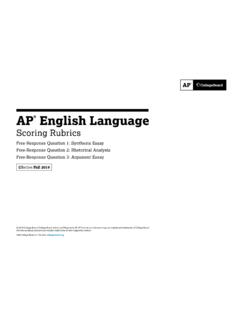Transcription of Models for Writers
1 Instructor s Manual forModelsforWritersShort Essays for Compositioneleventh edItIonAlfred RosaPaul EschholzPrepared bySarah SBoston New YorkCopyright 2012, 2010 (published March 2009), 2007, 2004 by Bedford/St. Martin sAll rights reserved. No part of this book may be reproduced, stored in a retrieval system, or transmitted in any form or by any means, electronic, mechanical, photocopying, recording, or otherwise, except as may be expressly permitted by the applicable copyright statutes or in writing by the in the United States of 5 4 3 2 f e d c b aFor information, write: Bedford/St. Martin s, 75 Arlington Street, Boston, MA 02116 (617-399-4000)ISBN: 978-0-312-55218-3iiiPrefacethe purpose of this Instructor s Manual is to help you use Models for Writers with the greatest effectiveness.
2 We therefore provide an analysis and key dis-cussion points for each selection in the book. In these sections of the manual, labeled Essay Analysis and Discussion, we share our experiences in teaching the essays: what to stress, what to explain, what to ask about, and what to expect in general from discussions. A typical analysis might do one or more of the following: explore one or more content issues Point out stylistic features Suggest classroom activities that reinforce rhetorical strategies Suggest one or more other essays in the text that might be usefully taught in conjunction with the present one explain where students are likely to have difficulty understanding either content or rhetorical techniquesIn addition, in the section Questions for Study and Discussion we provide suggested responses to the questions following each selection in Models for Writers .
3 Our intent is to save you time, not dictate answers. on occasion, you may disagree with our interpretation or emphasis, but we trust that the sug-gested responses will at least be useful as starting points. Your own experience with each essay will be invaluable, as will common sense about what will chal-lenge and engage your students. Also included in this manual are suggested an-swers for the Thinking Critically about This Reading exercises and detailed dis- cussions of what you might expect from each of the Classroom essays in Models for Writers are grouped into 21 chapters, each de-voted to a separate rhetorical topic. Chapters 3 through 10 focus on specific elements of essays: thesis, unity, organization, beginnings and endings, para-graphs, transitions, effective sentences, and writing with sources.
4 Chapters 11 and 12 concern some uses and effects of language: diction and tone, and figura-tive language. Finally, Chapters 13 through 21 explore types of essays: illustra-tion, narration, description, process analysis, definition, division and classifica- tion, comparison and contrast, cause and effect, and arrangement of the chapters suggests a logical teaching sequence, be-ginning with the elements of an essay, proceeding through the language of an essay, and then covering the types of essays. An alternative teaching strategy is to structure your course according to the types of essays, teaching other chapters as necessary or having students use them for reference. Finally, because each chapter is self-contained, you can design your own teaching sequence, omitting or emphasizing particular chapters according to the special needs of your help you use Models for Writers effectively, we would like to call your attention to the following special Section on reading and Writing Well.
5 In Chapter 1, the Writing Process, students learn useful questions to ask themselves as they un-dertake the writing process. By showing a student s essay in progress, beginning with developing an idea for an essay and ending in a final draft, the chapter al-lows students to see the writing process step by Chapter 2, From Reading to Writing, students learn how to become active readers. Annotated examples help students understand the best ways to prepare themselves to read a selection, read a selection for the first time, reread the selection, annotate the text with marginal notes, and analyze the text by asking questions. the chapter concludes with a discussion of how one uses reading in the writing process.
6 Here we include four annotated student essays to illustrate four types of essays narrative, response, reflective, and analytical that students typically write in college. In addition, the sample papers give stu-dents a good idea of the length and quality of writing they should be striving to produce. We therefore suggest that you assign the first two chapters early in the course and that you spend as much time as possible discussing the four student papers and their salient introductions. Before reading the essays in a particular chapter, students should read that chapter s introduction. there they will find an explana-tion of the rhetorical principle under consideration and a discussion of how it can be used.
7 The information in the introductions will also help students answer the questions and complete the writing assignments that accompany each on What You Know. Preceding each reading are prereading ac-tivities that prompt students to explore their own ideas and experiences regard-ing the issues presented in the thinking Questions. each selection is followed by a prompt that encourages students to think critically about their reading by exploring in discussion or in writing the author s meaning and assumptions as well as the broader implications of the for Study and discussion. the study questions for each selec-tion focus on its content, its author s purpose, and the rhetorical principle used to achieve that purpose.
8 Some questions require brief answers; others are in-tended to stimulate class discussion. Because students knowledge of rhetorical techniques and patterns will increase as the course proceeds, we have included for each essay one or more questions about rhetorical elements other than the one highlighted in the particular activities. these brief exercises (requiring fifteen to twenty minutes in most cases) enable students to work with each rhetorical element, technique, or pattern while in the classroom, often in groups. the activities in-cluded here will help students develop thesis statements, organize sentences within paragraphs , use strong action verbs, work with connotation and denota-tion, use figurative language, use examples to document a generalization, use facts effectively, work with outlines for comparison and contrast, test cause-and-effect relationships, classify on the basis of distinctive characteristics, and build argumentative evidence.
9 Frequently, these activities require students to engage in critical thinking and problem solving. We have used all these activities in our own writing classes, and our students have found them Writing assignments. At least two writing assignments accom-pany each essay in the textbook. they offer students the opportunity to apply the rhetorical principle at hand. often these assignments are also related to the content of the essays. If you prefer not to assign all the readings, most can be assigned Writing Prompts. Five new advertisements in the argument chapter encourage students to analyze the visual texts they see every Guide to Writing a research Paper. A new Chapter 22 on writing a research paper covers such essential topics as establishing a realistic schedule; finding, evaluating, and synthesizing print and online sources; taking notes; and developing a working bibliography.
10 Also provided are Models for using the most current Modern language Association documentation style, including in-text citations and lists of works cited, and a new annotated student research of Useful terms. the glossary, located at the end of the book, provides students with concise definitions of terms useful for discussing the readings and their own writing. Wherever we have believed that information in the glossary might assist students in answering a study question, we have placed a cross reference to the appropriate glossary entry next to the Contents. If a particular essay evokes strong student response, this alternative table of contents makes it easier for you to choose thematically related pieces in other sections of Models for Writers .












